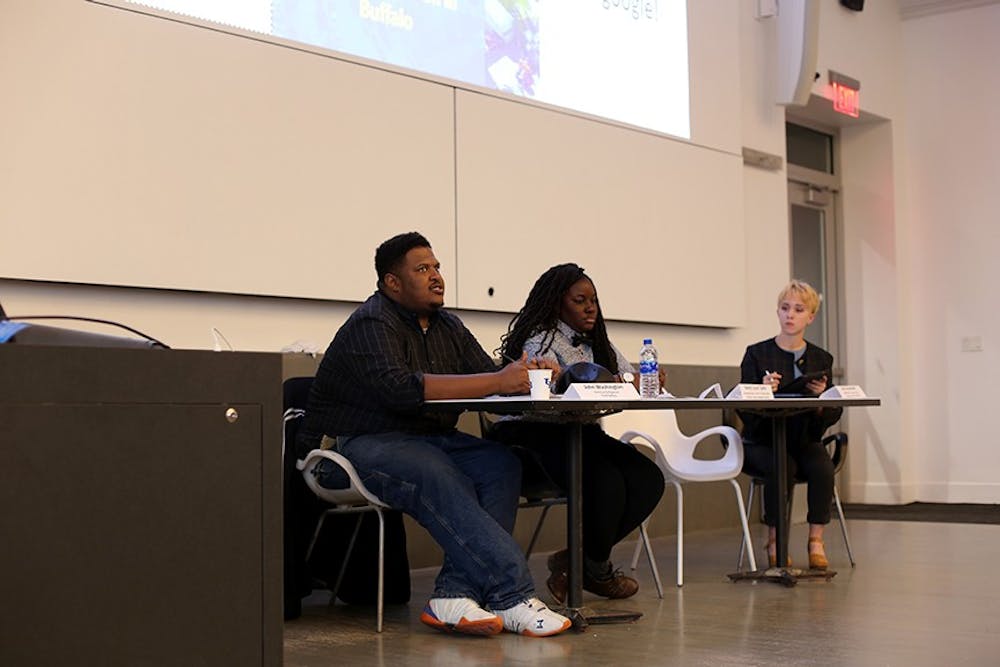Around 30 UB faculty, staff members and students gathered in Crosby Hall on South Campus Tuesday night to discuss their concerns on how the university impacts city neighborhoods.
DifCon, also known as Difficult Conversations, is a discussion series sponsored by the Office of Inclusive Excellence, which aims to bring members of the UB community together to discuss sensitive societal issues. Tuesday’s event featured two panelists who presented their views on gentrification: Jessica Coley, a graduate sociology student and recently elected 2018-19 Graduate Student Association president; and John Washington, a community organizer and member of PUSH Buffalo, a local organization aiming to establish more affordable housing opportunities in Buffalo’s West Side. Julia Schoonover, a graduate sociology student, moderated the discussion.
The conversation centered on segregation and the representation of people of color in downtown Buffalo. It looked at how some of the university’s plans negatively impacted the local community. The talk focused on the construction of UB’s medical campus in downtown Buffalo, and UB 2020, which aims to revitalize UB’s campuses through infrastructural projects in poor areas of Buffalo.
Washington explained the UB 2020 plan began in the 1990s as an initiative to move the university’s resources back to the city because of its relationship to downtown Buffalo.
The process of gentrification created an enormous inequality gap, as the expansion of Roswell Park Comprehensive Cancer Center, Jacobs School of Medicine and Biomedical Sciences and other similar institutions near the Fruit Belt neighborhood –– where property values were historically low –– changed the nature of the community, Washington said.
“Between 2004 and 2012, around 9,000 people moved out of the Fruit Belt area,” Washington said. “And even though there is no statistical way to prove it, if you go into the neighborhood and talk to the people that are left, most of them will say it’s because of rising home values, because their children and other people who were supporting them were continually getting harassed and because of the policing culture that was created.”
Coley expressed her concern over the small black population at UB, which is currently 8 percent of the student body, according to the U.S. Census Bureau. Coley said UB’s minority population is not representative of the 38 percent of Buffalo’s population that is black.
The movement of UB’s predominantly white community into traditionally black neighborhoods has led to displacement, Washington said.
Coley added that “well-educated” people who start to park their cars around the gentrified neighborhoods call the police on people of color standing outside the corner store or next to their cars at night, when the long-time residents were the ones who were there in the first place.
“I've talked to people in these neighborhoods, and they don’t think UB is doing a good enough job. They don’t think Buffalo is doing a good job,” Coley said. “They feel left out of these neighborhoods. They feel like they don’t even belong there anymore, so I think if we actually talk to the people whose opinions matter, to those who have been marginalized, they’re going to tell us that we’re doing a terrible job, and we need to listen to them.”
A Q&A session followed Washington’s and Coley’s speeches. The crowd asked the panelists questions.
Tanja Aho, the current GSA president, asked the panelists how students should pressure the university for not being responsive to communities like those in the Fruit Belt.
Washington told the crowd to engage in conversation with as many people as they can, and put pressure on whoever gets the most “pissed off” about it.
Jaycee Miller, a sophomore political science and environmental design major, asked panelists what they thought about the relationship between UB’s student population and University Heights residents.
Washington suggested the fraternities and sororities in the Heights area should do more work in the community, because they are the ones who “cause problems,” not Heights residents.
Miller said she lives in the Heights because she cannot afford housing around North Campus. She said the loud music and trash left behind by the Greek life parties is “annoying,” and feels like UB can do more to provide students with more affordable housing opportunities.
“Greek life volunteers for credit every semester, and they upkeep this image that they are working for community betterment,” Miller said. “But the amount of harm they do throughout the semester outweighs the good.”
Anna Savchenko is an assistant news editor and can be reached at anna.savchenko@ubspectrum.com or@annasavchenkooo.





